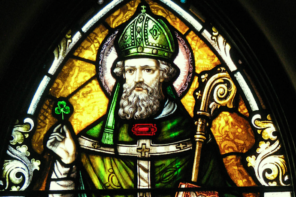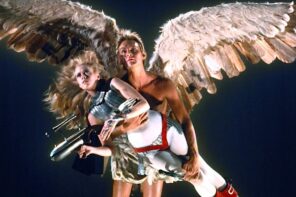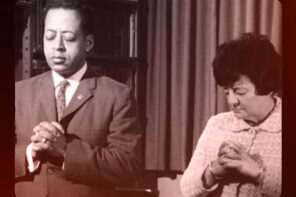What inspired you to write Theater in a Crowded Fire?
From my very first day at Burning Man in 1996, I’ve wanted to write about it. I was in my early years of grad school at the time and it didn’t take long to see that I’d stumbled into an extraordinary cultural petri dish in which people were consciously playing with art, symbol, and ritual in order to explore, expand, and reinvent the boundaries of late-modern culture.
Burning Man started as an impromptu gathering among a handful of friends on a San Francisco beach in 1986 and was moved to an obscure corner of Nevada called the Black Rock Desert in 1990, where it eventually grew into an internationally renowned event that draws close to 50,000 participants annually.
For one week in late August and early September, an elaborate civic infrastructure called “Black Rock City” is constructed, featuring a carefully laid out grid of streets in which participants set up hundreds of different “theme camps.” Organizers provide some basic services (camp placement, public information, and porta-potties being just a few), but participants must still supply all of their own gear, food, and water; sufficient to survive for one week in a very harsh desert environment. The Black Rock Desert is dominated by a dry lake bed called the playa—an absolutely flat and desolate expanse of cracked alkali clay—and the experience of camping there can be extreme.
At the center of the Black Rock City is the Burning Man icon itself: a towering wooden sculpture that is lit with multicolored shafts of neon and ultimately filled with fireworks and other incendiaries that detonate at the festival’s climax. Even more intriguing is the incredible array of art and ritual contributed by participants that often creatively appropriates symbols and motifs from the infinite well of humanity’s cultural and historical experiences—temples, labyrinths, demons, angels, gods, goddesses, priests, corporate logos, and more—almost anything imaginable is cobbled together in an incredible display of bricolage.
This decadent ritualism, which can be both sincere and satirical, casts the festival as a semi-religious cultural happening. Furthermore, many participants describe Burning Man as a “spiritual” experience, but deny that it constitutes a new religious movement as such. Organizers too explicitly hope that the event will “produce positive spiritual change in the world,” even while they also stop short of characterizing the event as “religious.” My work sought to explore the tension between “spirituality” and “religion” in the narratives of Burning Man participants in order to better understand how religio-cultural systems operate and adapt.
As a venue that emphasizes creativity and participation, Burning Man often inspires people to contribute their own unique talents and visions to the event. My particular art form is the academic study of religion and the practice of writing, so I see this book as my way of participating with the community.
What is the most important take-home message for readers?
Part of my intention has been simply to tell the story of Burning Man and to shed light on its immense ritual diversity. But ultimately I hope to challenge comfortable assumptions about the nature and location of religious practice.
The popular term “spiritual but not religious” only goes so far in describing an event like this. I think Burning Man shows us the enduring importance of ritual as a vehicle through which humans connect with one another and as well as with a mysterious “more,” while also showing us how these expressions are increasingly displaced outside the bounds of the dominant Western cultural concepts of “religion.” Burning Man is on the vanguard of contemporary religious movements that resist easy classification by favoring eclecticism and hybridity. Yet in articulating a clear ethos that places a core emphasis on building and supporting community—both inside and outside the confines of the week-long event—Burning Man manages to be individualistic and idiosyncratic without being solipsistic.
Is there anything you had to leave out?
As with any ethnography, especially one that spanned a decade of involvement, part of the challenge is to sift carefully through one’s field notes and memories and hone in on those stories that best serve the project’s goals. This was compounded further when we decided to create a DVD to accompany the text, thus necessitating another set of sacrifices to the cutting-room floor. But while there are thousands of details and stories I’m sure I could have told, I’m by and large happy with what I produced.
What are some of the biggest misconceptions about your topic?
Burning Man is a veritable magnet for misconceptions, so this is a great question. I think the biggest is to brand Burning Man as nothing more than a giant party rife with intoxicants, nudity, and bald hedonism. While it would be dishonest to claim that those elements are not present, they are neither as widespread nor as central to the event as many might assume. I think the easy stereotypes miss something much more important and interesting in how the event genuinely strives, and often succeeds, to be much more. Burning Man provides opportunities for deep reflection on intersections of self, community, and culture; and in so doing provides a venue in which to seek transformation for both the self and beyond. I also think it is symptomatic of America’s puritanical heritage to attempt to strip away the festal or carnivalesque elements of religion from what some might consider to be “authentic” piety. But historically and cross-culturally, opportunities for celebration are often part of the “package deal” that religions offer.
Another important aspect of Burning Man that often gets misunderstood is its critique of commodification. In order to create an experience where participants are cognizant of each other as individuals (rather than simply elements of a commodity exchange), the event defines itself as a “gift economy” rather than as a commercial festival. In practice, this means that—aside from an ice concession and a central café that sells only coffee and tea—no money is supposed to change hands within the confines of Black Rock City. Rather than paying or bartering for goods and experiences, participants are encouraged to give their resources, time, and creativity freely to one another. Event organizers also consistently refuse all offers of corporate sponsorship, believing that it would be antithetical to their vision for the event to do so.
On the flipside, this means that participants and others sometimes misconstrue the “gift economy” ethos as requiring Burning Man organizers to refrain entirely from engaging in the real-world marketplace, which would be pragmatically impossible. The event’s multimillion dollar annual budget is funded almost exclusively by ticket sales, and these tickets are not cheap (ranging this year, for example, from $210-$300 depending on time of purchase). This pays for the basic infrastructure as well as expenses like a hefty per-person/per-day use fee charged by the Bureau of Land Management. In addition, a significant portion of each year’s budget is set aside to fund many of the large-scale art installations various participants bring to the playa each year.
With issues like these in mind, part of how I’ve come to understand this event is by looking at the various ways in which participants are constantly contesting the event; challenging the organizers and one another to uphold the event’s ethos. As with any society, it’s through a dialectic of critique and conformity, transgression and tradition, that the event continues to evolve while also seeking to make an impact in what participants call the “default world” outside Black Rock City.
Did you have a specific audience in mind when writing?
I really tried to balance my perspective and tone for both academic and popular audiences. I obviously hope it is well-received by my colleagues, and I also hope that many Burning Man participants and others generally interested in the event will read the book and use it as a tool to reflect on their experiences.
Are you hoping to just inform readers? Give them pleasure? Piss them off?
As I said above, one of my key intentions is simply to illustrate the story of Burning Man. Ninian Smart’s phrase “religion on the ground” was one that stuck with me throughout the writing process, in that I sought—both through the narrative of the text and the DVD that accompanies it—to paint a portrait of the event that was at once critical, compassionate, accurate, and lively. (I owe Ron Grimes a nod of gratitude for putting that particular phrase in my head.)
I’m also seeking to broaden the dialogue about what “counts” as religious and why. Does the over-worn phrase “spiritual but not religious” adequately describe a phenomenon like this? Are individualistically authorized and eclectic spiritualities necessarily void of complex ritual traditions and a well-articulated community-based ethos? And what does all this potentially show us about the dynamics of cultural and religious change, looking to both the past and the future of religious practice?
What alternative title would you give the book?
I’m in love with the one I have and have been gratified to receive lots of positive feedback about it thus far. I share the story of how I came up with the title in the book, but will retell it briefly here. Two of my (adult) nieces were in attendance at the event one year and overheard a man enigmatically shouting “theater! theater!” in the midst of the chaos immediately following the climactic torching of the central effigy. (Although a safety perimeter is established around the Man as it ignites and burns, once it collapses people are free to surge toward and dance around the pyre.) My nieces puzzled over this for a moment, and soon realized this anonymous individual was indeed shouting “theater” in the midst of a rather “crowded fire.” When they told me this story later that night, I immediately seized on it as the title of what was at the time my dissertation as I thought it spoke brilliantly and provocatively to the event’s performative essence. I later learned that the phrase “Free speech means the right to shout ‘theatre’ in a crowded fire,” was cited as a “Yippie Proverb” by Abbie Hoffman in the introduction to Steal This Book, so I thought it was further appropriate as acknowledgement of Burning Man’s countercultural and “culture jamming” roots.
How do you feel about the cover?
I’m thrilled. Given the stunning visual power of so much that goes on at Burning Man, I was initially overwhelmed with possibilities. I had originally assumed the cover image would show, well, something on fire and much more obviously reflect and interpret the title. However, I was convinced by the designer and by this image’s arresting simplicity to go with the less literal choice. The photo is by an acquaintance of mine whose work I’ve long admired and I’m honored that he generously gave me this image to use.
Is there a book out there you wish you had written?
I deeply admire the work of writers who effectively link the personal and the analytical in ethnographic narratives. I sometimes worry that I may be criticized as being “too close” to my subject matter, and it’s true that in many ways I’m a participant first and a participant-observer second. But I think its rather disingenuous to attempt to completely strip away intimacy in writing about spiritual matters. So I’ve tried—with I’m sure greater and lesser success at various points—to balance both the subjective and the theoretical in this work.
What’s your next book?
This project has continued to gobble up a considerable share of my research and writing time these past few years, so I’ve yet to settle entirely on the next big project. My interests revolve broadly around expressions of what can be called “DIY spirituality,” akin to the general trends manifested at Burning Man, and I have written a bit on how this shows up in “social media.” I’ve also written a few articles about a group of performance activists known as Reverend Billy and the Church of Life After Shopping (they make a cameo in Theater) and have considered making them a more extensive project. Also, I’ve also been passionate about religion and ecology ever since I was an undergrad and am lately wanting to work more closely and deeply in that area again, linking it to my other interests.




